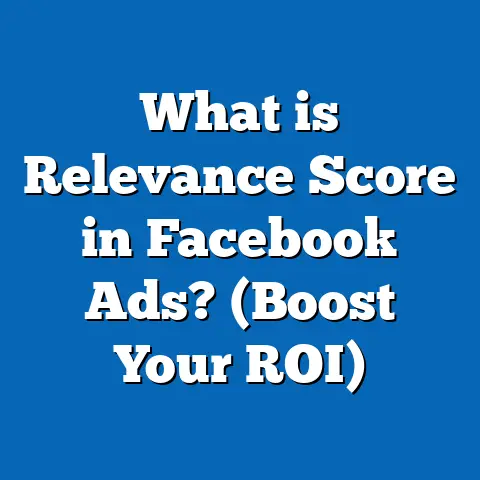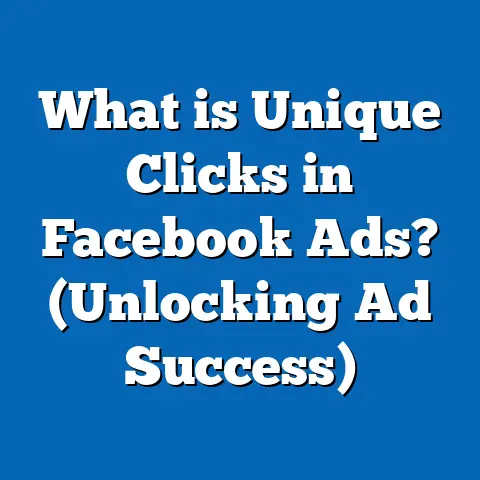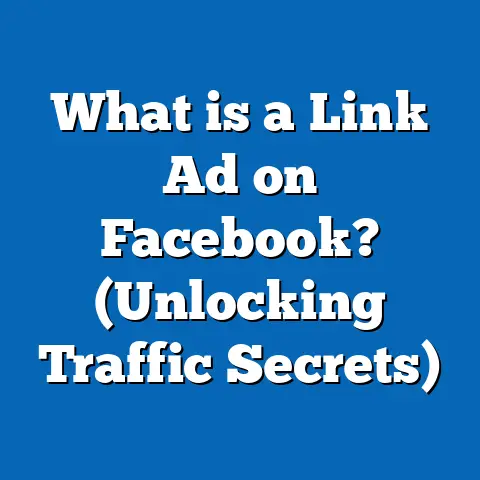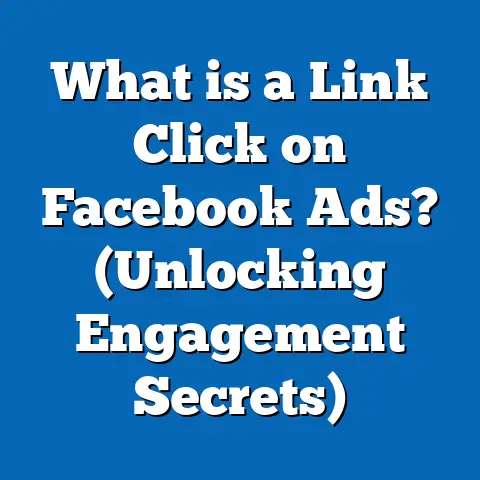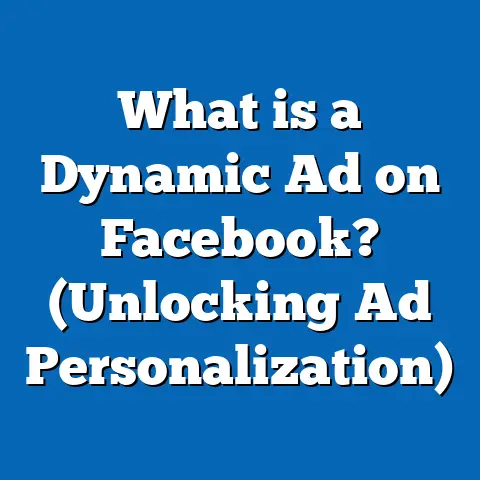What is Facebook Ad Conversion? (Unlocking Success Metrics)
What is Facebook Ad Conversion? (Unlocking Success Metrics)
Introduction: A Quick Win for Marketers
Imagine your Facebook ad campaign results in a 30% increase in sales within just one week. This isn’t a coincidence — it’s the power of understanding and optimizing Facebook ad conversion. Conversion is the beating heart of any successful advertising campaign because it translates engagement into tangible business results.
Understanding Facebook Ad Conversion
What Does “Ad Conversion” Mean?
At its core, a Facebook ad conversion is the action a user takes after engaging with your ad that aligns with the goal you set for your campaign. Unlike clicks or impressions which indicate interest, conversions are actual results — whether that’s making a purchase, signing up for a newsletter, filling out a lead form, or downloading an app.
Conversions are the most meaningful metric because they directly measure how well your ads drive desired actions that grow your business.
Types of Conversions Facebook Tracks
Facebook recognizes several common types of conversion events that advertisers can optimize for:
- Purchase: Completing a transaction on your website or app.
- Lead: Submitting contact or inquiry information.
- Add to Cart: Placing an item in a shopping cart.
- Complete Registration: Finishing a sign-up or membership form.
- App Install: Downloading or installing an app.
- View Content: Viewing specific pages or products.
- Search: Using site search features.
- Initiate Checkout: Starting the checkout process.
These predefined events help advertisers measure specific user behaviors tied to business goals.
Why Focus on Conversion?
Clicks and impressions show users’ interest but don’t guarantee they took meaningful steps toward becoming customers. According to WordStream’s 2023 Digital Advertising Report:
- Advertisers optimizing for conversions report an average 20% higher ROAS compared to those focusing on clicks or impressions.
- Conversion-focused campaigns reduce wasted spend by targeting users more likely to take action.
By prioritizing conversions, marketers can allocate budgets more effectively and scale their campaigns with confidence.
How Facebook Tracks Conversions
The Facebook Pixel: Your Data Collection Tool
The Facebook Pixel is a small piece of JavaScript code placed on your website that tracks visitor interactions resulting from your ads. It collects data such as page views, add-to-carts, purchases, and form submissions.
This data lets Facebook attribute conversions back to specific ads, audiences, and placements — crucial for measuring what works and optimizing campaigns.
How the Pixel Works:
- User clicks your Facebook ad.
- They land on your website where the Pixel has been installed.
- The Pixel records actions like product views or purchases.
- Data is sent back to Facebook Ads Manager for reporting and optimization.
Conversion API: Server-to-Server Tracking
Due to recent privacy changes (like Apple’s iOS 14+ updates), browser-based tracking has become less reliable. Facebook’s Conversion API (CAPI) allows businesses to send conversion data directly from their servers to Facebook.
Benefits include:
- More accurate tracking despite browser restrictions.
- Better data control and security.
- Ability to track offline conversions and CRM data.
Using Pixel and CAPI together creates a robust tracking system that captures more complete conversion data.
Setting Up Conversion Tracking Properly
Step 1: Install the Facebook Pixel
Proper Pixel setup is essential. Use Facebook’s Event Setup Tool or manually add code snippets on key pages like product pages, checkout, and thank-you pages.
Step 2: Define Your Conversion Events
Select which standard or custom events match your campaign goals. For example:
- E-commerce: Use “Purchase” and “Add to Cart.”
- Lead generation: Use “Lead” and “Complete Registration.”
Step 3: Test Your Pixel
Use the Facebook Pixel Helper Chrome extension to verify your Pixel fires correctly on all intended pages/events.
Step 4: Set Up Custom Conversions (if needed)
If your business requires tracking actions that don’t fit standard events, create custom conversions based on URL rules (e.g., thank-you page URLs) or custom parameters.
Measuring Facebook Ad Conversion Performance
Key Metrics Explained
Conversion Rate
The percentage of users who completed the desired action after clicking your ad. Conversion Rate=ConversionsClicks×100\text{Conversion Rate} = \frac{\text{Conversions}}{\text{Clicks}} \times 100
A higher conversion rate indicates more effective ads and landing pages.
Cost Per Conversion (CPC)
Average cost to get one conversion. CPC=Total Ad SpendNumber of Conversions\text{CPC} = \frac{\text{Total Ad Spend}}{\text{Number of Conversions}}
Lower CPC means more efficient spending.
Return on Ad Spend (ROAS)
Revenue generated per dollar spent on ads. ROAS=Revenue from AdsAd Spend\text{ROAS} = \frac{\text{Revenue from Ads}}{\text{Ad Spend}}
A ROAS above 1 means you’re making more money than you spend.
Industry-Specific Benchmarks
Benchmarks help evaluate if your campaign performs well relative to others. According to AdEspresso’s 2023 report:
| Industry | Avg. Conversion Rate | Avg. Cost per Conversion |
|---|---|---|
| E-commerce | 9.21% | $45 |
| Finance | 10.29% | $80 |
| Travel | 3.90% | $65 |
| Education | 11.45% | $35 |
Knowing these helps set realistic goals.
Crafting Effective Campaigns for Better Conversions
The Role of Audience Targeting
Facebook’s powerful targeting options let you pinpoint audiences most likely to convert:
- Core Audiences: Target by demographics, interests, behaviors.
- Custom Audiences: Retarget website visitors or existing customers.
- Lookalike Audiences: Find new users similar to your best customers.
Marketers using lookalike audiences report up to 30% higher conversion rates compared to broad targeting.
Ad Creative That Converts
Successful ads combine compelling visuals with clear messaging:
- Use high-quality images/videos showcasing product benefits.
- Include persuasive copy highlighting value propositions.
- Add strong Calls To Action (CTAs) like “Buy Now” or “Sign Up Today.”
Landing Page Optimization
Conversions don’t happen just on Facebook; your landing page must be optimized:
- Ensure fast loading speed (<3 seconds).
- Keep messaging consistent with the ad.
- Use clear CTAs and simple forms.
- Mobile-friendly design is crucial since over 80% of Facebook traffic comes from mobile devices.
Advanced Concepts in Facebook Ad Conversion
Attribution Windows: Understanding How Facebook Credits Conversions
Facebook uses timeframes called attribution windows to assign credit for conversions:
| Attribution Window | Meaning |
|---|---|
| 1-day click | Conversion within 1 day after clicking |
| 7-day click | Conversion within 7 days after clicking |
| 1-day view | Conversion within 1 day after viewing without clicking |
Choosing the right attribution window depends on your sales cycle length and customer behavior patterns.
Conversion Lift Studies
Conversion lift measures incremental conversions caused by your ads by comparing exposed groups with control groups not shown ads. This method helps quantify true ad impact beyond organic sales.
Value Optimization
Facebook’s Value Optimization bidding focuses on getting high-value conversions rather than just any conversion. This strategy suits businesses with products/services of varying prices or lifetime values.
Real-Life Case Studies: Learning from Success
Case Study 1: Retail E-commerce – 40% Sales Growth
Company: Mid-sized fashion retailer
Problem: High traffic but low purchase rates
Action Taken:
- Installed Facebook Pixel & set purchase event
- Created custom audiences for cart abandoners
- Ran video ads focused on product benefits
- Optimized campaigns for purchase conversions
Results:
- Sales increased by 40% in 6 weeks
- Cost per purchase dropped by 25%
- ROAS rose from 3x to 5x
This shows how tracking + retargeting + relevant creatives drive conversions.
Case Study 2: B2B SaaS Lead Generation – Doubling Quality Leads
Company: SaaS startup
Challenge: Low-quality leads from generic campaigns
Strategy:
- Used LinkedIn & Facebook lookalike targeting based on customer list
- Implemented lead forms with qualification questions
- Optimized for “Lead” conversion event with bid caps
Outcome:
- Lead volume doubled in 8 weeks
- Lead quality improved with higher demo signups
- Cost per qualified lead reduced by 30%
This highlights the importance of audience precision and conversion event optimization.
Practical Tips for Improving Facebook Ad Conversions
- Leverage Retargeting Aggressively
Retarget users who engaged but didn’t convert using dynamic product ads or special offers. - Test Multiple Creatives and Formats
Try videos, carousels, and stories to see what drives higher conversions for your audience. - Use Clear and Compelling CTAs
Avoid vague CTAs; direct users exactly what action to take next. - Optimize for Mobile Experience
Ensure landing pages look great and load fast on mobile devices. - Experiment with Bid Strategies
Test manual bids vs automatic bidding based on cost per conversion goals. - Monitor Attribution Window Performance
Adjust attribution settings based on how long your typical customer takes to convert. - Use Lookalike Audiences Based on Converters
Build lookalikes from high-value converters rather than just clicks or page views. - Employ A/B Testing Consistently
Test headlines, images, copy, and placement regularly to refine winning combinations.
Comparing Facebook Ads with Other Advertising Platforms on Conversion
| Platform | Strengths in Conversions | Ideal Use Case |
|---|---|---|
| Advanced audience profiling & retargeting | B2C brands, e-commerce, lead gen | |
| Google Ads | Intent-based search intent captures high intent | Immediate demand fulfillment |
| LinkedIn Ads | B2B targeting & professional demographics | Lead generation for professional services |
| Instagram Ads (via FB) | Visual storytelling + influencer integration | Lifestyle brands & younger demographics |
Facebook’s advantage lies in its detailed user data and diverse ad formats supporting both discovery and retargeting funnels.
Latest Trends Impacting Facebook Ad Conversion
Increased Privacy Regulations Affecting Tracking
Apple’s iOS 14+ update introduced App Tracking Transparency (ATT), requiring explicit user permission for tracking across apps and websites. This has reduced pixel effectiveness but accelerated adoption of server-side Conversion API solutions for improved data accuracy.
Growth of AI and Automation in Optimization
Facebook’s machine learning tools increasingly automate bid adjustment, budget allocation, and audience targeting based on real-time conversion likelihood predictions, helping advertisers reduce manual work while improving results.
Expansion of Ecommerce Features in Ads
Features like Facebook Shops, Instagram Checkout, and augmented reality try-ons create seamless user experiences directly within social platforms — driving shorter conversion paths.
Frequently Asked Questions (FAQs)
How soon can I expect conversions after launching a campaign?
Results vary but most campaigns start showing measurable conversions within 3–7 days once learning phase completes and optimization kicks in.
Can I track conversions if I also sell offline?
Yes! Using Facebook’s Offline Conversions tool you can upload sales data from physical stores or call centers and match it back to your ads for full-funnel measurement.
How do I choose between optimizing for clicks vs conversions?
If you want website traffic primarily for brand awareness or content consumption, clicks make sense; but if your goal is sales or lead capture, always optimize for conversions to get better ROI.
What if my website has low traffic?
Start with broad awareness campaigns first; then use retargeting once there’s enough pixel data collected for meaningful optimization toward conversions.
Conclusion: Unlocking Success Through Conversion Mastery
Facebook ad conversion sits at the center of effective digital marketing strategies. It transforms audience interest into measurable business outcomes like sales, leads, or app installs. By leveraging tools such as the Pixel and Conversion API, setting up detailed conversion events, analyzing key metrics like cost per conversion and ROAS, and continuously optimizing creative and targeting strategies, marketers can achieve significant growth.
Conversion mastery requires persistence — testing various audiences, creative formats, attribution windows, and bidding strategies until you find what works best for your unique business. Staying current with privacy regulations and platform updates will keep your campaigns competitive over time.
Next Steps for Marketers and Business Owners
To start unlocking success metrics today:
- Install Facebook Pixel & Conversion API immediately if not already done.
- Define crystal-clear campaign goals tied to specific conversion events.
- Start retargeting warm audiences who have shown interest but not converted.
- Test different creatives regularly while monitoring key performance metrics.
- Explore advanced strategies like value optimization and conversion lift testing.
- Stay informed about privacy changes and adapt tracking methods accordingly.
- Consider cross-platform strategies complimenting Facebook ads for best results.
Mastering Facebook ad conversion turns advertising spend into sustainable growth engines — ensuring every dollar works harder to bring customers through your digital doors.
Appendix: Additional Resources & Tools for Tracking Facebook Ad Conversions
- Facebook Business Help Center – Pixel Setup
- Facebook Ads Manager
- Facebook Conversion API Documentation
- Google Analytics Integration
- AdEspresso Benchmarks Report
- Pixel Helper Chrome Extension

